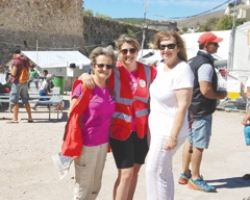
Chios, Greece, is described as a magic island where wanderlust is satiated and where mastic, an aromatic resin, is the chief ingredient in medicines, varnishes and liqueurs like ouzo.
Long, apartment style buildings with balconies are covered with “graffitom” ornate painted designs that resemble geometric black and white mosaics. Windmills and medieval villages grace the landscape of this idyllic Aegean island just a few miles off the Turkish coast.
American writer John Steinbeck said that “people don’t take trips — trips take people.” Pediatric nurse Carol Marr, of Seal Beach, would surely agree. In June of this year, Marr invested her precious three weeks of vacation time on that magic island of Chios, 130 miles east of Athens, assessing medical requirements of refugees from Syria, Iran and Afghanistan.
She first entertained the idea when she discovered her cousin Gail had participated the previous summer.
“When Gail told me she was returning in June, I asked if I could come along. She hardly knew what to say,” Marr said.
Healing for many refugees began in the caring hands of Marr. “I was most comfortable where I was needed most, working triage for the Chios Eastern Shore Response Team.”
A number of non-government agencies cooperated to support asylum seekers such as UNICEF and Save the Children.
A mere 30-minute ferry trip from Turkey, the transit Camp Souda, takes much longer to reach by crowded dinghy. Men, women and children had found places on rubber life rafts, most capable of holding only 60 individuals. Inferior life vests worn by refugees were filled with Styrofoam, which actually sinks when wet.
By the time they made landfall, many children suffered from hypothermia and dehydration.
Some women fasting during Ramadan were too undernourished to lactate. Bewildered, anxious survivors arrived wet, starving and disoriented. Some had witnessed executions of family members or had been tortured.
Teams of social workers from Colombia, France and the United States rendered assistance as did university students from South America and Northern Europe.
Helpers conducted initial medical assessment and distribution of clean, dry clothing, shoes and blankets. Refugees were fed hot noodle soup and tea and, for the youngest children, milk.
“Great care is taken to avoid the spread of communicable diseases in the close quarters,” Marr said. “Infants that cannot be breastfed must take formula from a tiny cup.” Sterilizing baby bottles is not feasible in the primitive conditions.
Photographs of the port were surreal. Embracing the transit shelter of containers and tents housing 2,000 refugees was Citadel Castle and medieval walls. Initially constructed in the 10th century, complete with turrets and palisades, it occupies a vast section of the main island port. Workers, shop owners, restaurateurs and refugees currently occupy this structure.
Marr and Gail began each work day at 8:30 a.m. at the Souda warehouse where volunteers signed a schedule with a list of needs for that day.
People were always needed to meet arrivals on shore, assess medical cases, prepare and serve meals, clean refuse from the beach and teach basic English in makeshift classrooms.
“During the time I was in Chios, former Second Lady Jill Biden was also on a mission to the island. You’d think the media would have been all over it,” Marr said.
It’s not all tranquility in Chios; the Greek island had depended heavily on the tourist industry. The influx of refugees has severely impacted this market.
“It gets to the point that the native population is stressed. There’s a limit to how much people can give … ” Marr left her sentiment half expressed.
“Originally, I had planned to stay a week in Athens. The architecture and museums are wonderful. There’s a new museum with a plexiglass floor. You can see ancient constructions below dating back two millennia. After three weeks at Camp Souda, I spent two days in Athens,” she said. She smiled with the satisfaction of spending her vacation well.
When asked if her career at Long Beach Memorial Children’s Hospital was imperative to her success with the project, Marr shrugged. “Anybody could have done it. It just takes a warm body that cares.”



